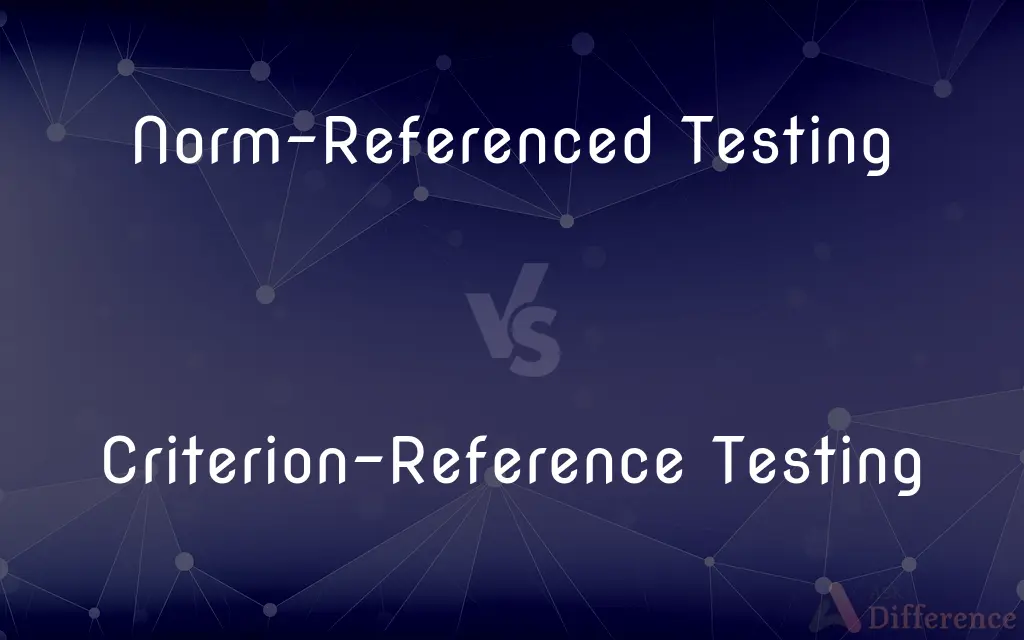Norm-Referenced Testing vs. Criterion-Reference Testing — What's the Difference?
Edited by Tayyaba Rehman — By Fiza Rafique — Published on November 18, 2023
Norm-Referenced Testing evaluates test-takers relative to each other, while Criterion-Reference Testing assesses their performance against defined criteria or a standard, focusing on specific learning objectives instead of peer comparison.

Difference Between Norm-Referenced Testing and Criterion-Reference Testing
Table of Contents
ADVERTISEMENT
Key Differences
Norm-Referenced Testing measures an individual’s performance relative to a larger group. In contrast, Criterion-Reference Testing gauges individual performance against a defined set of standards or skills.
The essence of Norm-Referenced Testing is comparative, determining where a student stands concerning peers. However, Criterion-Reference Testing is firmly anchored in achieving set benchmarks without considering how others perform.
Utilizing Norm-Referenced Testing, educators often discern overall rankings and percentile scores across a cohort. Criterion-Reference Testing, on the other hand, typically identifies whether a test-taker has successfully mastered specific skills.
While Norm-Referenced Testing could highlight the academic standing of a student among peers, Criterion-Reference Testing demonstrates whether a student can apply specific skills or knowledge.
Schools and institutions might employ Norm-Referenced Testing for selective purposes, whereas Criterion-Reference Testing might be used to verify if learning objectives are met, often seeking a pass/fail or mastery/non-mastery outcome.
ADVERTISEMENT
Comparison Chart
Main Focus
Comparative rankings
Mastery of specified skills
Score Interpretation
Relative to peer group
Against predefined criteria
Outcome Objective
Rank ordering
Mastery determination
Common Usage
Admission tests
Certification tests
Scoring
Typically normative (percentiles)
Often categorical (pass/fail)
Compare with Definitions
Norm-Referenced Testing
A testing approach measuring a participant against peer performance.
The SAT is a Norm-Referenced Testing method used for college admissions.
Criterion-Reference Testing
Evaluation that determines whether specific learning objectives are achieved.
Criterion-Reference Testing verifies if a student has mastered necessary mathematics skills.
Norm-Referenced Testing
An assessment where relative performance is the core focus.
Norm-Referenced Testing often determines a student's ranking within a larger peer group.
Criterion-Reference Testing
A test aimed at assessing skill mastery against defined criteria.
Driver’s license exams are Criterion-Reference Testing, assessing specific driving skills.
Norm-Referenced Testing
An evaluation where scores area interpreted relative to a norm group.
Norm-Referenced Testing places students on a bell curve, categorizing them accordingly.
Criterion-Reference Testing
Typically utilized for certification or to verify skill proficiency.
In Criterion-Reference Testing, passing signifies mastering required skills, irrelevant of others' performance.
Norm-Referenced Testing
A test often utilized for segregating or ranking test-takers.
Norm-Referenced Testing in schools may categorize students into various ability groups.
Criterion-Reference Testing
Frequently used to establish if learners have achieved requisite competency.
CPR certification uses Criterion-Reference Testing to ensure every certified individual can perform essential life-saving skills.
Norm-Referenced Testing
Typically employed for selective purposes in educational settings.
Elite programs may use Norm-Referenced Testing to select top-performing students.
Criterion-Reference Testing
Testing where performance is not evaluated against peer performances.
Criterion-Reference Testing determines if one passes without considering how others perform.
Common Curiosities
What is the primary difference between Norm-Referenced Testing and Criterion-Reference Testing?
Norm-Referenced Testing compares test-takers, while Criterion-Reference Testing evaluates against set criteria.
How does Criterion-Reference Testing determine if a student has passed or failed?
Criterion-Reference Testing assesses whether a test-taker meets predefined criteria or skill mastery.
Can one test include both Norm-Referenced Testing and Criterion-Reference Testing elements?
Yes, a test can potentially blend elements of both testing types, although it’s less common.
Are standardized tests typically Norm-Referenced Testing or Criterion-Reference Testing?
Many standardized tests, like the SAT, are examples of Norm-Referenced Testing.
Can Norm-Referenced Testing determine skill mastery?
No, Norm-Referenced Testing mainly indicates rank and is not focused on demonstrating mastery like Criterion-Reference Testing.
Share Your Discovery

Previous Comparison
Walnut Wood vs. Cherry Wood
Next Comparison
Formal Writing vs. Informal WritingAuthor Spotlight
Written by
Fiza RafiqueFiza Rafique is a skilled content writer at AskDifference.com, where she meticulously refines and enhances written pieces. Drawing from her vast editorial expertise, Fiza ensures clarity, accuracy, and precision in every article. Passionate about language, she continually seeks to elevate the quality of content for readers worldwide.
Edited by
Tayyaba RehmanTayyaba Rehman is a distinguished writer, currently serving as a primary contributor to askdifference.com. As a researcher in semantics and etymology, Tayyaba's passion for the complexity of languages and their distinctions has found a perfect home on the platform. Tayyaba delves into the intricacies of language, distinguishing between commonly confused words and phrases, thereby providing clarity for readers worldwide.














































